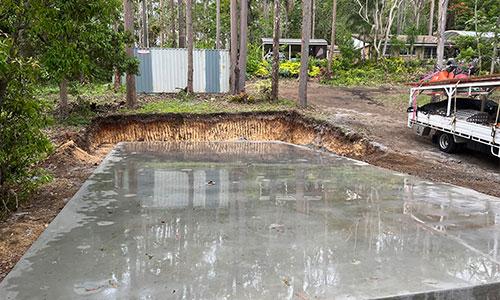
When it comes to building or renovating a home, concrete often works behind the scenes—literally. From the foundation to the driveway, footpaths, and even decorative elements, residential concreting plays a critical role in creating durable, long-lasting structures. Whether you're a homeowner planning a backyard upgrade or a contractor aiming for quality installations, understanding the scope and importance of residential concreting can make a significant difference in the success of your project.
What Is Residential Concreting?
Residential concreting refers to the use of concrete in private homes and residential areas. It includes a variety of applications such as:
- Slabs and foundations
- Driveways and footpaths
- Outdoor patios and entertainment areas
- Retaining walls and stairs
- Pool surrounds
- Garage floors and shed bases
These elements not only serve functional purposes but also contribute to the overall aesthetic and resale value of a property.
Why Concrete?
Concrete is one of the most versatile and widely used construction materials for residential projects—and for good reason:
- Durability: Concrete can withstand heavy loads and extreme weather conditions.
- Low maintenance: Unlike timber or asphalt, it doesn't rot, warp, or require frequent sealing.
- Cost-effective: Its longevity and minimal maintenance make it an economical long-term option.
- Customizable: Modern concrete can be stamped, coloured, and textured to suit different styles.
Types of Residential Concrete Finishes
Today’s homeowners have more options than ever before when it comes to concrete finishes. Here are a few popular choices:
- Exposed Aggregate
This finish is achieved by removing the top layer of cement paste to reveal the decorative stones beneath. It offers excellent slip resistance and visual appeal—ideal for driveways and walkways.
- Stamped Concrete
Stamped or patterned concrete mimics the look of stone, brick, or tile. It’s a cost-effective way to get a high-end look for patios and outdoor spaces.
- Coloured Concrete
By adding pigments during the mixing process or staining the surface, coloured concrete provides aesthetic flexibility to match your home’s design.
- Polished Concrete
This sleek and shiny finish is perfect for indoor floors. It’s easy to clean and incredibly modern in appearance.
- Broom Finish
A simple, non-slip surface created by dragging a broom across freshly poured concrete. It’s often used for driveways and pathways due to its practicality.
The Residential Concreting Process
Here’s a basic breakdown of how most residential concreting projects are completed:
- Planning and Design
This phase involves choosing the type of concrete, finish, and layout. Proper planning ensures drainage, durability, and compliance with local regulations.
- Site Preparation
The site is cleared, leveled, and compacted. A stable sub-base is essential to prevent cracking and sinking.
- Formwork
Temporary molds or forms are set up to define the shape and edges of the concrete. This stage ensures accurate dimensions.
- Pouring and Finishing
Concrete is mixed and poured into the formwork. It’s then leveled and finished according to the desired style—whether that’s smooth, textured, or patterned.
- Curing
Curing is the process of allowing the concrete to reach its full strength. This typically takes 7 to 28 days and involves keeping the concrete moist and protected.
Common Challenges and How to Avoid Them
Even though concrete is a strong material, improper installation can lead to problems down the road. Here are some common issues and solutions:
- Cracking: Caused by poor preparation or rapid drying. Always ensure a proper sub-base and follow correct curing techniques.
- Discolouration: Uneven colouring may result from inconsistent mixing or weather conditions. Use high-quality pigments and sealants.
- Scaling or flaking: Often due to freeze-thaw cycles or poor finishing. Using a good sealer and appropriate curing helps prevent this.
Hiring a professional with experience in residential concreting is the best way to avoid these issues.
Sustainable Practices in Concreting
As homeowners and builders grow more environmentally conscious, there’s a shift toward sustainable concrete practices:
- Recycled aggregates (like crushed concrete) reduce waste and demand for new materials.
- Cool pavements using light-coloured concrete reflect more sunlight, reducing urban heat.
- Permeable concrete allows water to seep through, helping manage stormwater and recharge groundwater.
By choosing eco-friendly materials and methods, you can reduce your project’s environmental impact while maintaining structural integrity.
Choosing the Right Contractor
The success of your concreting project largely depends on the contractor’s expertise. Here’s what to look for:
- Experience with residential projects
- Positive reviews and references
- Licensed and insured
- Willingness to provide detailed quotes and timelines
- Portfolio of past work
Don’t hesitate to ask questions about their process, materials, and timelines.
Final Thoughts
Residential concreters are more than just pouring grey slabs. It’s a foundation—literally and figuratively—for a home that lasts. With the right planning, skilled contractors, and modern finishes, concrete can transform spaces into beautiful, functional, and durable areas suited to any lifestyle.
Whether you’re building a new home, upgrading a driveway, or creating the ultimate backyard patio, investing in quality residential concreting is a decision that pays off for decades.